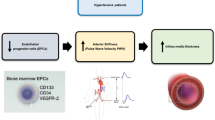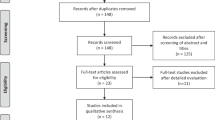Abstract
We have recently demonstrated the diagnostic value of a new immunophenotype of blood endothelial progenitor cells (EPCs=CD45neg/CD34pos/CD144pos) and endothelial microparticles (EMPs=CD45neg/CD144pos/AnnexinVpos) in patients with arterial erectile dysfunction (ED) according to severity of cavernous arterial insufficiency evaluated through penile Doppler. The aim of this study was to evaluate both EPCs and EMPs in patients with arterial ED and metabolic syndrome (MetS), comparing these patients with another group of patients without MetS and ED and a third group with MetS but without ED. For this study 50 patients with arterial ED and MetS were selected (age: 55.0±3.0 years; range: 47–60). A group of age-matched (age: 54.0±2.0 years; range: 44–60) patients without arterial ED and MetS (n=30), and another group of age-matched (age: 57.0±4.0 years; range: 40–62) patients with MetS but without ED (n=20) represented the control groups. EPCs and EMPs were significantly higher in patients compared with other groups (P<0.01). Both EPCs and EMPs correlated positively with the age, body mass index, and score of international index of ED (version five items) and with the following cavernous artery indices: peak systolic velocity, acceleration time and intima-media thickness. Among control groups patients with MetS but without ED showed serum concentrations of EPCs and EMPs significantly higher (P<0.05) compared with patients without MetS and ED. Patients with arterial ED and MetS have higher EPCs and EMPs compared with patients with MetS but without ED and patients without MetS and ED.
This is a preview of subscription content, access via your institution
Access options
Subscribe to this journal
Receive 8 print issues and online access
$259.00 per year
only $32.38 per issue
Buy this article
- Purchase on Springer Link
- Instant access to full article PDF
Prices may be subject to local taxes which are calculated during checkout


Similar content being viewed by others
References
La Vignera S, Vicari E, Condorelli RA, Di Pino L, Calogero AE . Arterial Erectile Dysfunction: Reliability of Penile Doppler Evaluation Integrated with Serum Concentrations of Late Endothelial Progenitor Cells and Endothelial Microparticles. J Androl; advance online publication, 25 August 2011 (e-pub ahead of print).
Rosen RC, Cappelleri JC, Smith MD, Lipsky J, Pena BM . Development, evaluation of an abridged, 5 item version of the International Index of Erectile Function (IIEF-5) as a diagnostic tool for erectile dysfunction. Int J Impot Res 1999; 11: 319–326.
Benson CB, Aruny JE, Vickers Jr MA . Correlation of duplex sonography with arteriography in patients with erectile dysfunction. Am J Roentgenol 1993; 160: 71–73.
Speel TG, van Langen H, Wijkstra H, Meuleman EJ . Penile duplex pharmaco-ultrasonography revisited: revalidation of the parameters of the cavernous arterial response. J Urol 2003; 169: 216–220.
National Cholesterol Education Program (NCEP) Expert Panel on Detection, Evaluation, and Treatment of High Blood Cholesterol in Adults (Adult Treatment Panel III). Third Report of the National Cholesterol Education Program (NCEP) Expert Panel on Detection, Evaluation, and Treatment of High Blood Cholesterol in Adults (Adult Treatment Panel III) final report. Circulation 2002; 106: 3143–3421.
Wang C, Nieschlag E, Swerdloff R, Behre HM, Hellstrom WJ, Gooren LJ et al. ISA, ISSAM, EAU, EAA and ASA recommendations: investigation, treatment and monitoring of late-onset hypogonadism in males. Int J Impot Res 2009; 21: 1–8.
Real C, Caiado F, Dias S . Endothelial progenitors in vascular repair and angiogenesis : how many are needed and what to do? Cardiovasc Hematol Disord Drug Targets 2008; 8: 185–193.
Asahara T, Murohara T, Sullivan A, Silver M, van der Zee R, Li T et al. Isolation of putative progenitor endothelial cells for angiogenesis. Science 1997; 275: 964–967.
Werner N, Junk S, Laufs U, Link A, Walenta K, Bohm M et al. Intravenous transfusion of endothelial progenitor cells reduces neointima formation after vascular injury. Circ Res 2003; 93: 17–24.
Kong D, Melo LG, Gnecchi M, Zhang L, Mostoslavsky G, Liew CC et al. Cytokine-induced mobilization of circulating endothelial progenitor cells enhances repair of injured arteries. Circulation 2004; 110: 2039–2046.
Urbich C, Dimmeler S . Endothelial progenitor cells: characterization, role in vascular biology. Circ Res 2004; 95: 343–353.
Güven H, Shepherd RM, Bach RG, Capoccia BJ, Link DC . The number of endothelial progenitor cell colonies in the blood is increased in patients with angiographically significant coronary artery disease. Am Coll Cardiol 2006; 48: 1579–1587.
La Vignera S, Condorelli R, Vicari E, D'Agata R, Calogero AE . Arterial erectile dysfunction: reliability of new markers of endothelial dysfunction. J Endocrinol Invest 2011; 34: e314–e320.
Demir T, Demir O, Kefi A, Comlekci A, Yesil S, Esen A . Prevalence of erectile dysfunction in patients with metabolic syndrome. Int J Urol 2006; 13: 385–388.
Baumhakel M, Werner N, Bohm M, Nickening G . Circulating endothelial progenitor cells correlate with erectile function in patients with coronary heart disease. Eur Heart J 2006; 27: 2184–2188.
Esposito K, Ciotola M, Maiorino MI, Giugliano F, Autorino R, De Sio M et al. Circulating CD34+ KDR+ endothelial progenitor cells correlate with erectile function and endothelial function in overweight men. J Sex Med 2009; 6: 107–114.
Case J, Mead LE, Bessler WK, Prater D, White HA, Saadatzadeh MR et al. Human CD34+ AC133+ VEGFR-2+ cells are not endothelial progenitor cells but distinct, primitive hematopoietic progenitors. Exp Hematol 2007; 35: 1109–1118.
Hirschi KK, Ingram DA, Yoder MC . Assessing identity, phenotype and fate of endothelial progenitor cells. Arterioscler Thromb Vasc Biol 2008; 28: 1584–1595.
Esposito K, Ciotola M, Giugliano F, Sardelli L, Giugliano F, Maiorino MI et al. Phenotypic assessment of endothelial microparticles in diabetic and nondiabetic men with erectile dysfunction. J Sex Med 2008; 5: 1436–1442.
Werner N, Kosiol S, Schiegl T, Ahlers P, Walenta K, Link A et al. Circulating endothelial progenitor cells and cardiovascular outcomes. N Engl J Med 2005; 353: 999–1007.
Delva P, De Marchi S, Prior M, Degan M, Lechi A, Trettene M et al. Endothelial Progenitor Cells in Patients with Severe Peripheral Arterial Disease. Endothelium 2008; 15: 246–253.
Foresta C, De Toni L, Biagioli A, Ganz F, Magagna S, Caretta N . Increased levels of osteocalcin-positive endothelial progenitor cells in patients affected by erectile dysfunction and cavernous atherosclerosis. J Sex Med 2009; 7: 751–757.
Ingram DA, Caplice NM, Yoder MC . Unresolved questions, changing definitions, and novel paradigms for defining endothelial progenitor cells. Blood 2005; 106: 1525–1531.
Shet AS . Characterizing blood microparticles: technical aspects and challenges. J Vasc Health Risk Manag 2008; 4: 769–774.
Morel A, Ohlmann P, Epailly E, Bakouboula B, Zobairi F, Jesel L et al. Endothelial cell activation contributes to the release of procoagulant microparticles during cardiac allograft rejection. J Heart Lung Trasplant 2008; 27: 38–45.
Combes V, Simon AC, Grau GE, Arnoux D, Camoin L, Sabatier F et al. In vitro generation of endothelial microparticles and possible prothrombotic activity in patients with lupus anticoagulant. J Clin Invest 1999; 104: 93–102.
Freyssinet JM, Toti F, Hugel B, Gidon-Jeangirard C, Kunzelmann C, Martínez MC et al. Apoptosis in vascular disease. Thromb Haemost 1999; 82: 727–735.
Diamant M, Nieuwland R, Pablo RF, Sturk A, Smit JW, Radder JK . Elevated numbers of tissue-factor exposing microparticles correlate with components of the metabolic syndrome in uncomplicated type 2 diabetes mellitus. Circulation 2002; 106: 2442–2447.
Freyssinet JM . Cellular microparticles, what are they bad or good for? J Thromb Haemost 2003; 1: 1655–1662.
Boulanger CM, Amabile N, Tedgui A . Circulating microparticles a potential prognostic marker for atherosclerotic vascular disease. Hypertension 2004; 48: 180–186.
Esposito K, Ciotola M, Giugliano F, Schisano B, Improta L, Improta MR et al. Endothelial microparticles correlate with erectile dysfunction in diabetic men. Int J Impot Res 2007; 19: 161–166.
Author information
Authors and Affiliations
Corresponding author
Ethics declarations
Competing interests
The authors declare no conflict of interest.
Rights and permissions
About this article
Cite this article
La Vignera, S., Condorelli, R., Tumino, S. et al. Original evaluation of endothelial dysfunction in men with erectile dysfunction and metabolic syndrome. Int J Impot Res 24, 150–154 (2012). https://doi.org/10.1038/ijir.2012.7
Received:
Revised:
Accepted:
Published:
Issue Date:
DOI: https://doi.org/10.1038/ijir.2012.7



